|
|
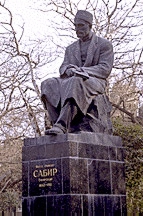 |
 |
Right: Sabir (first monument to a literary figure in Baku) in 1922.
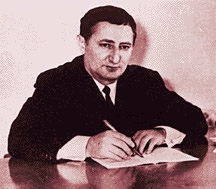 |
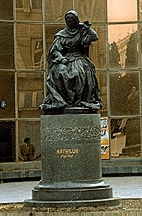 |
Right: Natavan, 19th Century Poetess
 |
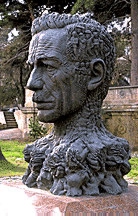 |
 |
Center: Vahid, 20th Century Poet
Right: Jafar Jabbarli, 20th Century Poet and Playwright
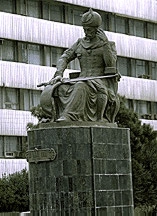 |
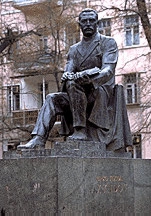 |
Right: Akhunzade, 20th Century Poet and Playwright
Sabir (sah-BIR)
Behind each statue is
a fascinating story. I'll mention just a few. The first monument
to a literary figure in Baku was built in 1922 to commemorate
Sabir (1862-1911). Azeris still appreciate his satirical poems
written at the turn of last century. Many of his works are still
relevant and resonate with the same satirical sting. Sabir was
a sharp-tongued, witty poet with immense courage.
He openly criticized the backwardness of the clergy at a time
when their influence upon the Azerbaijani society was overwhelmingly
oppressive - not like nowadays. In his allegorical works, Sabir
alluded to the fact that he was less afraid to be in a place
where there might be devils and ghosts, than in one where there
were fanatics. Such remarks brought threats to his life. "You
may be able to kill my weak body," Sabir would reply, conscious
of how chronically ill he was with tuberculosis, "but you'll
never be able to destroy my poems."
Fortunately, Sabir died in 1911 prior to the revolutionary clashes
and subsequent horrors of Stalin's era. Why fortunately? Because
had he lived beyond 1920, no doubt like many other famous and
gifted Azeri poets, he would have been silenced one way or another,
either via exile or execution.
In 1922 (only ten years after his death), a statue was erected
to Sabir's memory to mark the 60th commemoration of his birth.
Keylikhos, a talented Baku sculptor of Jewish origin, created
a life-size figure depicting Sabir in a standing position.
In 1958 this statue was replaced by another, designed by the
famous Azeri sculptor, Jabbar Qaryagdy. This time the poet was
shown sitting down, immersed in deep thought. Contrary to what
might be expected, the sitting position is much more striking
and prominent.
Replacement of the Sabir statue led to a joke that was quite
widespread throughout Baku at the time. "To force someone
to sit down" in Russian slang means "to imprison someone."
People used to jest that the Soviet authorities had finally succeeded
in "seating" Sabir.
Women Poets
Some of Azerbaijan's
most gifted and most courageous poets were women. Just to be
accepted as writers, they had to challenge many societal conventions
and restrictions. Nowadays, Azeris deeply cherish the names of
two outstanding women poets, Mehsati Ganjavi (12th century) and
Natavan (19th century).
Natavan lived in the city of Shusha (nowadays occupied by Armenians)
and was deeply respected for her poetry and wisdom. A magnificent
monument of this beautiful, but sad, Oriental lady who lost her
teenage son to tuberculosis, was created by Omar Eldarov and
erected on the promenade near the Azerbaijan Cinema in Baku (See
also AI 2:2, 34, 1994). There is also a bronze bust to her memory
which has been brought to Baku from Shusha. Pocked by bullet
holes, it stands as another mute witness to the casualties that
have resulted in the war over Nagorno-Karabakh.
Nizami Literature
Museum
Two buildings in Baku
are famous for rows of literary statues built into the portals
of the architectural design-the Akhundov National Library and
the Nizami Literary Museum. Originally, the Nizami Literature
Museum housed the luxurious Metropol Hotel, which was considered
among the most fashionable at the turn of the 19th century. In
1941 the hotel was totally remodeled and converted into a literature
museum to coincide with the commemoration of Nizami's 800th anniversary.
Today, it stands as one of the most distinct and prominent buildings
in the entire city. (See magazine cover).
Six monuments to literary figures stand in its portals. Among
them are some of the most prominent Azeri poets, writers and
thinkers whose works span centuries. There is Fizuli (15th century),
Vagif (18th century), Akhundov and Natavan (19th century) and
finally Mammadgulizade and Jabbarli (20th century).
Nizami
Overlooking the Museum,
perched on a very high pedestal is a statue of Nizami himself
(1141-1204). This writer is highly respected by Azerbaijanis
and considered one of the early creators of Oriental poetry.
He was revered as a "living encyclopedia" because of
his vast, comprehensive knowledge which he acquired without even
leaving his home city of Ganja (from which his literary name
"Ganjavi" is derived). Azerbaijanis often consider
his poems such as "Treasury of Mysteries," "Khosrow
and Shirin," "Leyli and Majnun," "Seven Beauties,"
and "Iskandar-Nameh" not just as poetic works in the
traditional sense, but as philosophical treatises.
World War II interrupted the building of this statue as many
creative projects were postponed during those years. Nizami's
statue took eight years to complete. The sculptor Abdurahmanov
also had to deal with the problem of imagining what the poet
might have looked like as there were no sketches of him from
the 12th century.
There are many more monuments than those we have featured here.
It is virtually impossible for most people in Baku to go about
their everyday activities without passing at least one of them
during the course of a day. Those who live or work in the center
of the city are surrounded by these reminders of our literary
heritage.
Since ancient times, Azeris have held their poets and literary
figures in highest esteem, always raising them high on a pedestal
in their minds. Elderly people, who know so many long passages
of literary works from memory, will tell you that it was our
precious literary heritage that helped preserved the Azeri character,
its values and traditions, and which shielded us during the Soviet
period with all its terror and oppression when so many of our
talented literary figures were intimidated, arrested and silenced.
Today, these memorials in marble, granite and bronze give witness
to the incredible intellectual legacy these great thinkers have
given us-linking us to our own past and enabling us to preserve
our identity as we step forward into the future.
From Azerbaijan
International (4.1)
Spring 1996.
© Azerbaijan International 1996. All rights reserved.
Back to Index
AI 4.1 (Spring 1996)
AI Home | Magazine
Choice
| Topics
| Store
| Contact
us
